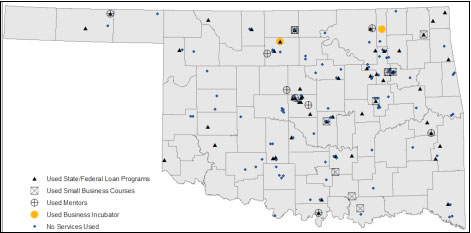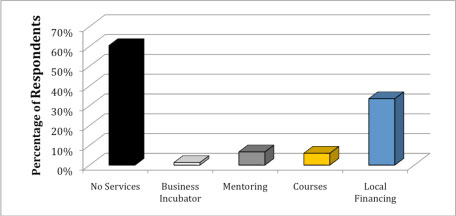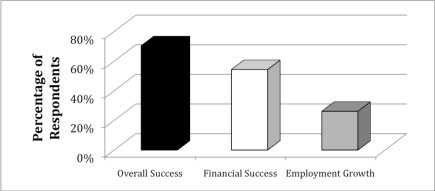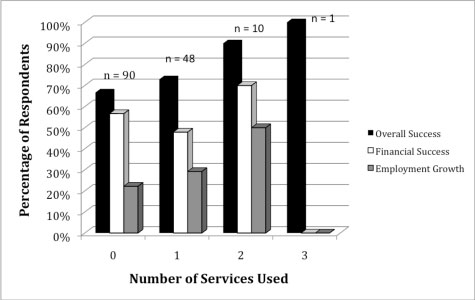 |
February 2012
|
February 2012 // Volume 50 // Number 1 // Feature // v50-1a10
Small and Home-Based Businesses: Measures of Success and the Contribution of Local Development Services
Abstract
Small and home-based businesses have long been identified by Extension educators as an important component of economic development, particularly in rural areas. The services available to these businesses can take many forms, including management training, accessibility of local funding, providing incubation facilities, or setting up mentoring relationships. Extension educators wanting to promote certain services should be aware of historical rates of use of these programs and their impacts on various success measures for small businesses. State-level survey results of small business owners are used to discuss the services used, different measures of success, and statistical relationships between the two.
Introduction
Small and home-based businesses have long been identified by Extension educators as an important component of economic development, particularly in rural areas (Owen & Passewitz, 1986; Bastow-Shoop, Leistritz, Ekstrom & Zetocha, 1990; Shuster, 2001). Extension is not alone in catering to small businesses, with numerous federal and state government programs focusing on ways to promote entrepreneurship and provide needed services for these companies. These include the Small Business Administration (SBA), the United States Department of Agriculture (USDA), and even the Internal Revenue Service (IRS). In today's economy, small businesses are more important than ever, comprising 99.7% of all employer firms, employing around half of the country's private sector workforce, and creating about 65% of all net new jobs over the past 2 decades (SBA Office of Advocacy, 2010).
Given these statistics, communities are increasingly focusing on job creation through the development and growth of small local businesses rather than the recruitment of outside firms (Walzer, 2004; Muske, Woods, Swinney, & Khoo, 2007). In particular, communities have increasingly focused on entrepreneur development and their ability to create new market opportunities and supporting existing small businesses in expanding the local job market. Johnson, Rightmyre, and Chatman (2004) describe entrepreneurs as individuals who envision something that did not exist before, create something new, or provide an existing product or service in a new way. In the same manner, small businesses are believed to be the innovators of today's economy (Edmiston, 2007).
Because of this potential impact to their economy, communities and Extension personnel are interested in how they can aid small business activity in their own district. This can include increasing the numbers of entrepreneurs/small businesses and attempting to improve their overall rates of success. While various factors have been hypothesized to be important in developing small business owners and aiding in their success, there is little empirical analysis to accompany these beliefs. The Extension literature, in particular, focuses on services that an educator might provide, such as encouraging community-based business orientation or serving as a clearinghouse of information (Loker, Scannell, Furry, & Heck, 1990). This discussion generally stops short of recognizing which particular programs or services might be recommended or providing statistics on how many local small businesses have achieved success after using different types of available services.
The services or programs available to local entrepreneurs/small businesses can take many forms, from small business management training, to making loan funds locally available, to providing incubation facilities, or even setting up mentoring relationships with successful local business owners. As rural communities face declining tax bases due to out-migration, leakages, and recession-related fiscal stress, knowing which of these programs best utilizes scarce funds is critical. A partial answer to this question comes by understanding which services small business owners have utilized in the past and the success rates of businesses using various programs.
A related question for Extension educators is "What defines success for a small business owner?" Most studies have focused on financial measures or numbers of jobs created, but are these the most important to a small business owner? Can a small business owner define his or her business as successful even if it is not financially successful? Given that an Extension educator has multiple tasks—namely, to help the individual business owner with their personal goals while also improving the economy of the community—understanding how and why different success measures may be used by the small business owner can help the educator better perform his or her job.
This article seeks to answer some of these questions using a 2006 statewide random survey of Oklahoma small business owners. Namely, two distinct topics are explored:
- Which specific small-business oriented services are being used?
- How do self-reported perceptions of success vary across business owners?
Combining these topics generates several interesting results, including which services are related to specific success measures. This information can be used by Extension educators as they seek to promote different types of services to small business owners. Informing a new owner about the services available to them is one thing, but being able to tell them that a particular service had a measurable impact on success in a state-level study is likely to be much more helpful.
Data and Methods
The Oklahoma Social Indicator Survey, conducted by the Bureau for Social Research at Oklahoma State University, completed 1,233 surveys of residents 18 years of age or older in late 2006. This telephone survey was conducted via random-digit dialing to ensure non-biased results. The survey asked basic demographic questions such as education level and race, and also inquired whether or not someone in the household was a small business owner. After removing observations with missing data, 149 respondents (12.4% of the original sample) fell into this category. These small business owners were then asked about the availability and use of services that might have influenced the small business owner. Four common services were identified as possible responses. The four services that the research reported here focuses on were:
- Business incubators (common area with shared services for start-up businesses)
- Mentoring programs
- Courses on starting a small business
- Local financing—loan or investor services (including state or federal loan programs administered via local financial institutions)
Respondents answered yes or no to participation in each service. The goal of the research was to understand whether using certain types of programs/services has meaningful results on one objective and two subjective measures of business success. The specific questions included:
- Self-perception of their overall
business success
- Likert rating from 1 (very unsuccessful) to 5 (very successful)
- "Success" defined as Likert ratings 4 or 5 (binary final measure)
- Self-perception of the financial
success of their business in the past 2 years
- Rated as increased, decreased, or stayed the same
- "Success" defined as increased financial success (binary final measure)
- Whether or not they have added jobs to
their business in the past 5 years
- "Success" defined as any positive growth (binary final measure)
Results
Figure 1 shows the location of small business respondents and the particular services each utilized. There was a large amount of geographic variation, with responses obtained from all regions in the state. Perhaps most striking is the large number of small business owners who did not use any type of service (60%). This could be indicative of a lack of interest, or a lack of knowledge about service availability. It was also interesting to see that business owners using one or more of the featured services (incubators, mentoring, training or financing) tend to be clustered near the metropolitan areas of the state [Oklahoma City is central, while Tulsa is in the northeast] where these programs may be more accessible. It appeared that loan programs are popular regardless of geographic location.
Figure 1.
Location of Respondents by Services Used

Figure 2 shows the services that were most often used by respondents. As indicated above, the majority (60%) of respondents chose to use no services at all. As expected, the most highly utilized service was financing provided at the local level (this included federal and state loan subsidy programs provided through local financing institutions). Over 30% of business owners responding to the survey took advantage of locally provided financing for their business. By comparison, only around 6-7% of respondents participated in mentoring or small business training classes, and only 1% used business incubators. Several respondents used more than one type of service. It is worth noting that the low response rate for mentor use may have been due to the respondent's assumption that the question referred to a formal mentoring program. The rate may have risen if the question were re-phrased to emphasize informal learning from other small business owners.
Figure 2.
Service Utilization by Respondents

Figure 3 displays the averages for the three different success measures. Interestingly, a higher percentage of business owners indicated that their business was successful overall (71%) than financially successful (54%). Only about 26% said that their business added employees over the past 5 years. These results make it clear that overall business "success" varies among individual owners and typically means more than simple financial achievements. In fact, 34% of those who classified their business as an overall success did not classify it as a financial success. These variations could relate to opinions about being in control of one's schedule, the amount of time dedicated to work, or simply the ability to spend their day working in an area they enjoy. Also worth acknowledging is the fact that the survey design did not allow for differentiation between full- and part-time businesses. This could further influence how a small business owner defines success. Educators should be aware that not all small business owners are focused on "bottom line" monetary success measure, and might want to focus on services that would help an owner improve their time management skills, for example.
Figure 3.
Percentage of Respondents Classifying Their Business as Successful Using Three Different Measures

To uncover more meaningful relationships between the different measures of success and various programs, t-tests are used to compare mean values between successful and unsuccessful small business owners. Business owners were not asked to identify specific services that factored into their success; rather, we looked at the correlations between success and the various services used. Table 1 displays these descriptive statistics for the four programs in question. For instance, out of all businesses that classified themselves as an overall success, 1.9% used a business incubator. Comparatively, out of all businesses that classified themselves as unsuccessful overall, none (0%) used an incubator.
These differences are not statistically different, indicating that use of a business incubator does not have a meaningful relationship with overall success. In fact, most of the mean values displayed in Table 1 do not display significant differences between successful and unsuccessful measures. Only two differences are measurably different at the p = 0.05 or 0.10 levels: Individuals who used courses are more likely to consider themselves successful overall, and individuals who used local financing are more likely to have seen employment growth. Thus, participation in several programs in our sample (business incubators and mentors) did not result in significantly higher rates of business success regardless of the measure used.
| Overall Business Success | Financial Success | Employment Growth | ||||
| Successful | Unsuccessful | Successful | Unsuccessful | Successful | Unsuccessful | |
| Services Used | ||||||
| Business Incubator | 0.019 | 0.000 | 0.000 | 0.029 | 0.026 | 0.009 |
| Mentoring | 0.076 | 0.046 | 0.074 | 0.059 | 0.051 | 0.073 |
| Courses | 0.086 | 0.000 ** | 0.086 | 0.029 | 0.077 | 0.055 |
| Local Financing | 0.352 | 0.296 | 0.296 | 0.382 | 0.462 | 0.291 * |
| * and ** indicate that the successful / unsuccessful means are statistically different at the p = 0.10 and p = 0.05 levels, respectively | ||||||
As a final investigation, the impact of participating in a combination of services to encourage success among business owners is explored. Figure 4 displays overall, financial, and employment success measures for businesses that participated in none, one, two, or three of the four programs in our survey (no one participated in all four). Interestingly, there is little variation between those who choose to use no services and those who choose to use one. Rates of overall success and employment growth increase only slightly (from 67% to 73% and 22% to 29%, respectively) for those choosing to use one service instead of none, but rates of financial success actually fall (from 57% to 48%).
Among those using two different services, however, all three measures of success are notably higher. This may be representative of the underlying effort of the business owner—those willing to participate in multiple training/educational programs are likely the same ones highly dedicated to seeing their business succeed. Only one respondent chose to use three services, and so the success measures for this final category may not be too meaningful. However, the trend line for overall success is clear, with more services used leading to higher perceived success.
Figure 4.
Percent of Successful Businesses by the Number of Services Used

Conclusion and Discussion
The survey results indicate that while communities in Oklahoma offer a variety of services for entrepreneurs and small business owners, there is no guarantee that they will be used. More than half of the small businesses in our sample did not use any service. Given this result, two useful roles for Extension would be: (1) to simply be aware of existing small businesses in their area and (2) to make local business owners aware of the programs that are available to them. Both of these suggestions reinforce the findings of Muske and Stanforth (2000), who focused on the educational needs of small business owners. Accomplishing these tasks would involve partnerships with (or at least awareness of) local community colleges, technology centers, small business development centers, or non-profit economic developers that may offer some of the services discussed above. These entities may also have lists of local small business owners. Extension may offer some of these services themselves—namely small business courses—and should be included in any final list of available programs.
More detailed recommendations can also be provided from the results of this research. Extension educators should be aware of what programs have been popular historically. Of those small business owners who did use specific programs, local financing was the most commonly used (34%), with only a small percentage taking advantage of mentors, incubators, or small business courses (1-7%). Because many small business owners are interested in financing, this could potentially be used as a "hook" to attract participants to other programs (for example, mentioning funding in the title of a workshop but also providing information on other services).
Educators should also acknowledge the possibility that businesses will use alternative measures of success. The research demonstrates that business owners evaluate their business' success by non-financial means (e.g., greater control over one's schedule, desire to be one's own boss), given the disparity between perceived overall success and financial success. Many small businesses did not add employees, but still considered themselves to be successful overall. This suggests that employee growth is not an overly important consideration for many small business owners, some of whom could be single-person businesses or family businesses with little desire to grow in size.
Perhaps the strongest recommendations that can come out of the research reported here are the suggestions of particular programs tailored to specific success measures. In particular, we show that participation in small business courses has a statistically significant, positive relationship with overall business success, while using local financing programs has a significant positive relationship with adding employees (Table 1). These can be very useful once an Extension educator uncovers the goal of a particular business owner.
Last, a community can increase business owner success by promoting the use of more than one program, as the use of multiple programs by business owners appears to provide the highest perception of success (highlighted by the trend line in Figure 4). Educators may wish to stress the significantly higher rates of overall success for those choosing to participate in two programs versus those choosing not to use any (90% vs. 67%). Financial success and employment growth are much higher for this group as well. Again, this may be a by-product of the underlying amount of work these small business owners are willing to do to see their business succeed, but having specific data to back up participation rationale can be very useful for those involved in Extension.
References
Bastow-Shoop, H., Leistritz, F., Ekstrom, B., & Zetocha D. (1990). Home-based business...A means to economic growth in rural areas. Journal of Extension [On-line], 28(2) Article 2FEA6. Available at: http://www.joe.org/joe/1990summer/a6.php
Edmiston, K. (2007). The role of small and large businesses in economic development. Federal Reserve Bank of Kansas City Economic Review. 92(2):73-97.
Johnson, T., Rightmyre, V., & Chatman, D. (2004). Growing entrepreneurs from the ground up: A community-based approach to growing your own business. Community Policy Analysis Center, University of Missouri-Columbia.
Loker, S., Scannell, E., Furry,, M. & Heck, R. (1990). Building home businesses in rural communities. Journal of Extension [On-line], 28(2) Article 2FEA5. Available at: http://www.joe.org/joe/1990summer/a5.php
Muske, G.M., & Stanforth, N. (2000). The educational needs of small business owners: A look into the future. Journal of Extension [On-line], 38(6) Article 6FEA4. Available at: http://www.joe.org/joe/2000december/a4.php
Muske, G., Woods, M., Swinney, J., & Khoo, C. (2007). Small businesses and the community: Their role and importance within a state's economy. Journal of Extension [On-line], 45(1) Article 1RIB4. Available at: http://www.joe.org/joe/2007february/rb4.php
Owen, W., & Passewitz, G.. (1986). Programs for home-based business. Journal of Extension [On-line], 24(1) Article 1IAW5. Available at: http://www.joe.org/joe/1986spring/iw5.php
Shuster, C. (2001). Beyond a dream: Starting your own small or home-based business. Journal of Extension [On-line], 39(3) Article 3IAW3. Available at: http://www.joe.org/joe/2001june/iw3.php
Small Business Administration Office of Advocacy. (2010). Frequently Asked Questions. Retrieved from: http://www.sba.gov/advo/stats/sbfaq.pdf
U.S. Department of Commerce, Census Bureau. Population by County. (2008). Retrieved from: http://www.census.gov
Walzer, N. (2004). Introduction: Entrepreneurship in community development. Journal of the Community Development Society. 35, 1-4.




